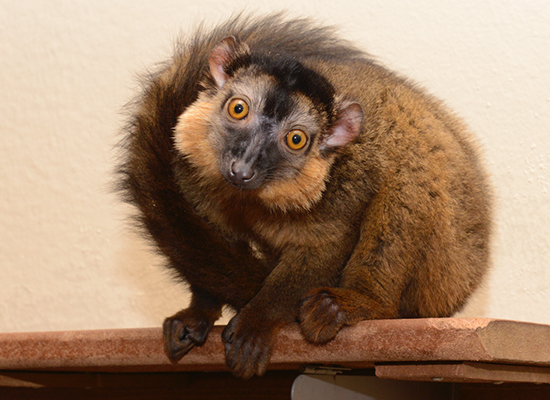Eulemur collaris
Red-collared brown lemurs, also called collared lemurs, are found in coastal forests in southeastern Madagascar. These littoral forests provide an important buffer for both human-built structures and wildlife habitat against strong ocean winds and storms. Unfortunately, as people build closer to the water, these forests are becoming more fragmented. Red-collared brown lemurs are a major seed disperser in these important forests and their conservation is key to ongoing forest recovery efforts in Madagascar.
Unlike most species of lemur which are female dominant, collared lemurs are co-dominant: there does not appear to be a clear dominance hierarchy within groups.
Collared lemurs are endangered in Madagascar. Primary threats include bushmeat hunting, capture for the local pet trade, and habitat loss due to slash-and-burn agriculture (required for traditional rice farming), and burning hardwood trees to produce charcoal.
In response, the DLC’s SAVA conservation program in Madagascar distributes fuel-efficient “Rocket Stoves” to local Malagasy families. These stoves can reduce wood and charcoal use by 50%, which reduces pressure on forest resources and slows forest destruction – and helps not only lemurs but also the Malagasy people: The stoves, in addition to being more fuel efficient, improve women’s and children’s respiratory health through improved kitchen air quality.
Adult size: 5 - 5.5lbs (2.3 - 2.5 kg)
Social structure: male-female pairs, with offspring
Habitat: tropical moist lowland and coastal forest in Southeastern Madagascar
Diet: fruit, flowers, nectar in the wet season, bark, sap, soil, and insects in the dry
Sexual maturity: 1 year
Mating: Seasonal, infants are born in November and December in Madagascar, September, and October in North Carolina
Gestation: 120 days
Number of young: 1 - 2 per season
IUCN Status: endangered
DLC Naming theme: French names
Malagasy name: Varika
Adult collared lemurs can be about the size of a large house cat, weighing about 5.5 lbs (2.6kg) with a body length of 16 inches (41cm), with a tail as long as 22 inches (55cm).
Collared lemurs are sexually dichromatic. Males are brownish-gray with a dark stripe down the back, a dark tail and tail tip, and a lighter underside. Females have a reddish to brown coat and a gray face. Both sexes have a distinct beard that is reddish-brown in females and cream to reddish-brown in males.
Red-collared lemurs, the species housed at the Duke Lemur Center, are distinguished from the very similar white-collared lemurs by a slightly darker beard.
Collared lemurs have a diet mostly consisting of fruit, young leaves, and flowers. In Madagascar, collared lemurs’ diets fluctuate with the seasons. In the dry season, fruit is less available and collared lemurs will spend more time foraging for lower-calorie foods like leaves, bark, and soil.
Due to their generalist feeding patterns groups of brown lemurs tend to do well in human care where their diet of primate chow, fruit, and vegetables is available year-round.
Collared lemurs are seasonal breeders, with mating season occurring between June-July. Gestation last approximately 120 days, and infants are born between September and November. One offspring a year is typical. Collared lemurs reach sexual maturity at about 1 year old.
Collared lemurs are sociable, living in groups of 3 – 12 individuals. Groups as large as 29 have been observed and the size of the group is variable with fluctuations in seasonal food availability. Groups may contain adult males and females and multiple pairs will mate in a season. Unlike many species of lemur which are female dominant, there does not appear to be a clear dominance hierarchy within groups.
When food is plentiful, groups are very cohesive and stay close together as they move through the forest feeding on leaves and fruit. The animals are usually found high in the canopy and they rarely descend to the ground. In the dry season, groups may split into smaller feeding groups in search of food. As forests become increasingly fragmented, collared lemurs have been observed moving on the ground from one fragment to another, generally traveling at night when there is less risk of being caught out in the open by a bird of prey. They are one of the most cathemeral lemurs, meaning they are regularly active during the day and at night.
There may be a significant overlap (up to 20%) of the ranges of neighboring groups, which occasionally leads to hostile (but not violent) territorial encounters. Home range boundaries are maintained by vocalizations. Their home range tends to span 17 – 50 acres (7 – 20 ha), usually in the scattered forest fragments of the high plateaus in southeastern Madagascar, from the Mananara River near Vangaindrano south to Fort-Dauphin.
The collared lemur is found in lowland and mid-altitude primary and secondary rainforest in a small range in the southeastern tip of Madagascar from the Mananara River near Vangaindrano south to Fort-Dauphin. This range stretches to the coast of the Indian Ocean and includes littoral coastal forest. These littoral forests provide an important buffer for both human-built structures and wildlife habitat against strong ocean winds and storms. Unfortunately, as people build closer to the water, these forests are becoming more fragmented. Red-collared brown lemurs are a major seed disperser in these important forests and their conservation is key to ongoing forest recovery efforts in Madagascar.
Collared lemurs are found in only one protected area in Madagascar. They are classified as endangered by the International Union for Conservation of Nature (IUCN). Primary threats include bushmeat hunting, capture for the local pet trade, and habitat loss due to slash-and-burn agriculture (required for traditional rice farming) and burning hardwood trees to produce charcoal.
Watch Celene, one of our youngest collared lemur infants, investigate her mother’s apple and vegetable breakfast. At only a month old, solid foods weren't quite on the menu yet for little Celene.



